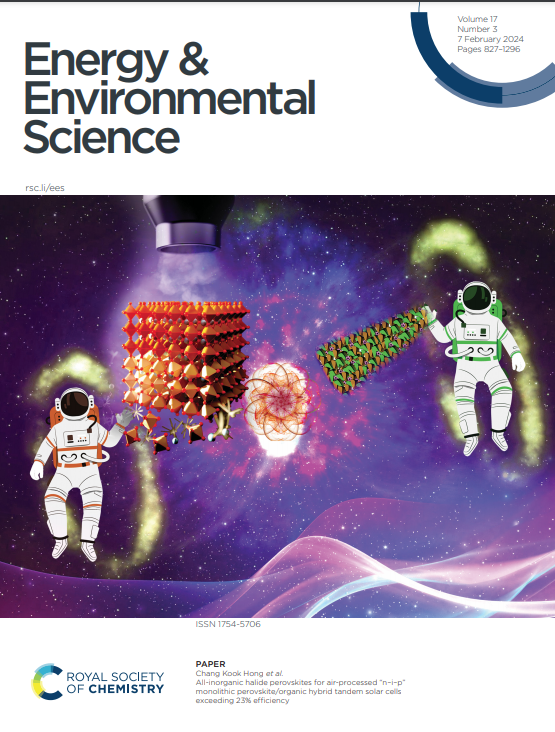Trace molecular chelation engineering of a self-healing hybrid interphase for highly stable aqueous zinc-ion batteries
IF 30.8
1区 材料科学
Q1 CHEMISTRY, MULTIDISCIPLINARY
引用次数: 0
Abstract
Aqueous Zn-ion batteries (AZIBs) hold promise for grid-scale storage due to their intrinsic safety and low cost, yet face critical irreversible anode degradation from dendritic proliferation and parasitic reactions. Here, we introduce a molecular chelation-driven interfacial engineering strategy using trace polyglutamate sodium (PS) to construct a dynamically selfhealing hybrid interphase on Zn anodes. PS reorganizes interfacial water networks and chelates Zn 2+ , forming an adaptive hydrogel-like PS-Zn layer (PSZ), which further in situ generates an inorganic solid-electrolyte interphase (SEI). This synergistic PSZ-SEI layer provides robust electrode shielding, precise hydration regulation, and continuous self-repair. Consequently, Zn||Zn symmetric cells achieve >4500 h cycling, Zn||Na 2 V 6 O 16 •3H 2 O full cells exhibit stable cycling for 1000 cycles in coin cells and 180 cycles in pouch cells (N/P ratio = 1.62) under high cathode loading (~12 mg cm -2 ). The universality of this approach is further demonstrated in Zn||I 2 batteries over 5000 cycles. This ppm-level dynamic interface control resolves long-standing interfacial conflicts in practical AZIBs.高稳定锌离子水电池自修复杂化界面的微量分子螯合工程
由于其固有的安全性和低成本,水性锌离子电池(azib)有望用于电网规模的存储,但面临枝晶增殖和寄生反应导致的不可逆阳极降解。本文介绍了一种分子螯合驱动的界面工程策略,利用微量聚谷氨酸钠(PS)在锌阳极上构建动态自愈的杂化界面。PS重组界面水网络并螯合zn2 +,形成自适应水凝胶样PS-Zn层(PSZ),进一步在原位生成无机固体-电解质界面相(SEI)。这种协同的PSZ-SEI层提供了强大的电极屏蔽,精确的水合调节和持续的自我修复。因此,在高阴极负载(~12 mg cm -2)下,Zn||Zn对称电池实现了>;4500 h的循环,Zn|| |Na 2v 6 O 16•3H 2o全电池在硬币电池中表现出1000次循环和180次循环(N/P比= 1.62)的稳定循环。这种方法的普遍性在超过5000次循环的Zn b|i2电池中得到进一步证明。这种ppm级的动态接口控制解决了实际azib中长期存在的接口冲突。
本文章由计算机程序翻译,如有差异,请以英文原文为准。
求助全文
约1分钟内获得全文
求助全文
来源期刊

Energy & Environmental Science
化学-工程:化工
CiteScore
50.50
自引率
2.20%
发文量
349
审稿时长
2.2 months
期刊介绍:
Energy & Environmental Science, a peer-reviewed scientific journal, publishes original research and review articles covering interdisciplinary topics in the (bio)chemical and (bio)physical sciences, as well as chemical engineering disciplines. Published monthly by the Royal Society of Chemistry (RSC), a not-for-profit publisher, Energy & Environmental Science is recognized as a leading journal. It boasts an impressive impact factor of 8.500 as of 2009, ranking 8th among 140 journals in the category "Chemistry, Multidisciplinary," second among 71 journals in "Energy & Fuels," second among 128 journals in "Engineering, Chemical," and first among 181 scientific journals in "Environmental Sciences."
Energy & Environmental Science publishes various types of articles, including Research Papers (original scientific work), Review Articles, Perspectives, and Minireviews (feature review-type articles of broad interest), Communications (original scientific work of an urgent nature), Opinions (personal, often speculative viewpoints or hypotheses on current topics), and Analysis Articles (in-depth examination of energy-related issues).
 求助内容:
求助内容: 应助结果提醒方式:
应助结果提醒方式:


